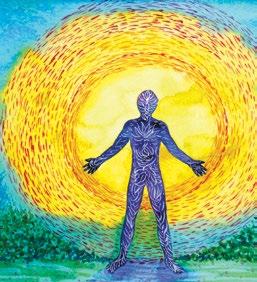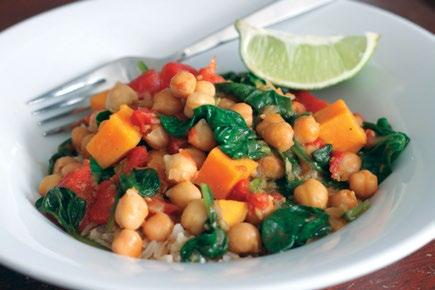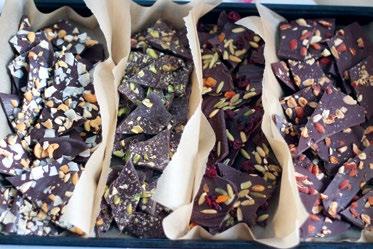Let’s face it – life as we knew turned upside down these last few years. We’ve all cut back on social commitments, missed family milestones and faced a lot of uncertainty. Studies show that social isolation is linked to higher risks for high blood pressure, heart disease and a weakened immune system. It can also lead to anxiety and depression, and may even cause a decline in memory or brain function. Good news, though! There are simple things you can start doing today to refocus on your physical (body), mental (behavioral) and cognitive (brain/memory) health. Read on for tips to help you start feeling your best again, body, mind and spirit. And remember, you are not alone. All of us at eBrightHealth ACO are here to help!


1
Me, myself, I… and WE! We’re all in this together! Check out the Foods that fuel your BRAIN insert. How pets touch our hearts and our brains 6 WAYS TO IMPROVE YOUR HEALTH at home! News from your Primary Care Team and eBrightHealth ACO FALL 2022 If you put off preventive services and recommended screenings, today’s the day to get back on track. Your Annual Wellness Visit is a great place to start. Schedule yours today! “Let your food be your medicine.” HIPPOCRATES The magnesium in pumpkin seeds (also called pepitas) mayhelp relieve anxiety and stress to makeyou feel calmer. The seeds also contain iron, which can help improveyourmood, and zinc,which helpswith memory. ‘Tis the season! Leafygreenspinach packedwith good-for-yourbrain nutrients shown to help off mental decline. Avocados are a good source Bvitamins that play role in producing brain chemicals to reduce and boost mood. Avocados also provide the nutrient lutein, which improves memoryand problem-solving ability. Dark chocolate contains cocoa flavanols, an antioxidant that’s been shown reduce inflammation, which is linked to depression. Moderate amounts of caffeine can help increase alertness and attention and mayeven help lessen feelings ofdepression. But too much can be, well… too much! Limityourselfto just a fewcups a day. Chickpeascombine complex carbohydrates to fuelyour brain protein to keepyou alert, and folic acid to boost memory. An eggyolk is packedwith more than 20% ofthe daily recommended amount oftryptophan, an amino acid needed to produce serotonin. Serotonin helps ease stress and promote feeling ofcalm. Eggyolk also good source of Vitamin D,which helps protect against memoryloss and forgetfulness. Drinking more water help raiseyourspirits since mild dehydration can make you feel down in the dumps. Fruit,leafyvegetables, fish nuts packedwith omega-3 fattyacids may help improve mental focus. Antioxidant-rich greentea mayenhance memoryand mental alertness. Sweetpotatoes, are in magnesium, one of best minerals promoting calmness and improving mood. Omega-3s andVitamin D in “fattyfish” like salmon tuna mayhelp reduce anxietyand depression, improve memoryand boost cognitive function. lack ofVitamin has been linked increased stress levels. Yellowbellpeppers contain almost twice muchVitamin as oranges and halfthe sugar. Magnesium-rich beets also help increase levels of serotonin, which we need to fight anxiety, fatigue and irritability. Giveyourdiet boostwith these delicious foods that arejust as good for yourbrain as theyare foryourbody! Choose those high invitamins, minerals and antioxidants that nourishyou and are shown to promote happiness. Foods that fuel your BRAIN
It’s a GREAT DAY to be alive!
After the last few years of pandemic restrictions, it’s never been so important to reconnect with family, friends and our community. Even if you live alone, you don’t have to feel alone! Take the first step today and reach out to those you love. Get involved in your community. And remember, your Primary Care Team and eBrightHealth ACO can help you put a plan in place to start feeling like yourself and living your best life again.
6 ways to Be Well. Stay Well. from head to toe and heart and soul
1. USE YOUR HEAD!
Read, learn a new language, play an instrument. Puzzles and brain games help sharpen skills such as planning, reaction time, decisionmaking and short-term memory. Plus, they’re fun!
2. GET PHYSICAL!
The more you move, the better you’ll feel. Take walks, swim, do yoga, dance! Stretching, cardio and strength training are not just great for your body. They can help you manage stress, anxiety and depression, too. Bonus: new skills help you boost confidence and reduce your risk of falls.
3. KEEP IN TOUCH!
Go out for lunch or enjoy a walk in the park with a friend. Sign up for a book club or cooking class together. Having trouble getting together in person? Phone, email, text, connect on social media or plan a video visit. Better yet, make someone’s day by mailing a card or letter. Everyone loves finding those in their box!
4.
BRUSH UP ON NEW SKILLS!
Bucket lists don’t have to mean wild adventures like skydiving or trips around the world (although those would be fun!). Take an art class. Rekindle your love for woodworking, cooking or gardening. Try something you’ve always wanted to do!
5.
GIVE AND GET BACK!
Read to young children, help at the local food pantry, deliver meals or drive neighbors to appointments and errands. Volunteering is a great way to meet new people and you’ll feel valued and needed in return. It’s a win-win for everyone!

6. PRACTICE GRATITUDE!
Expressing gratitude can actually help reduce stress and brighten your mood, which in turn can improve your physical health. Take a few minutes each day to find the beauty around you. Keep a gratitude journal. Send a thank you note. While you’re at it, don’t forget to appreciate just how wonderful YOU are.
2
Mental Health Matters
We all feel down once in a while. But when depression starts to affect your life and health, it’s time to ask for help.
10 signs that you or someone you love may be struggling with depression


1. Spending more time alone. 2. Changes in appetite or weight (increase or decrease). 3. New or increased confusion or disorientation.

4. Unexplained physical symptoms, such as digestive issues, muscle tension or pain, sweating and shaking. 5. Changes in mood or energy level that last more than two weeks. 6. Changes in personal hygiene or home maintenance. 7. Loss of interest in favorite activities. 8. Trouble concentrating or making decisions. 9. Difficulty sleeping or sleeping too much.
10. Increased worry, obsessive thinking or compulsive behavior.
Medicare Part B may help pay for some outpatient mental health services, such as one depression screening per year, individual or group counseling, family counseling, some prescription medications, diagnostic tests and partial hospitalization. Talk with your doctor or visit MyMedicare.gov to check your coverage.
Dial 911 for life-threatening concerns or go directly to the Emergency Department. Dial 988 for the Suicide & Crisis Lifeline.
To find a local Mental Health Association (MHA) near you for counseling services, wellness groups, mental health apps and podcasts visit mhanational.org and click “Find your local MHA”
Mental health affects physical health. If you have a chronic condition such as COPD, diabetes, heart disease, or high blood pressure, depression can make it harder for you to follow your care plan.
Your Primary Care Team or another trusted health professional can help!
“They say a person needs just three things to be truly happy in this world: someone to love, something to do, and something to hope for.”
Puppy love
According to the Centers for Disease Control and Prevention, the bond between humans and their pets can help increase fitness, decrease blood pressure, lower stress and bring happiness. That’s doggone good news if you ask us!
Not sure you want to commit to caring for a pet full time? Offer to pet sit for a friend or neighbor or volunteer at a local animal shelter. Watching nature shows can even help lower anxiety and improve your mood.
3
— TOM BODETT
Beneficiary to Beneficiary






Good grief
Holidays can be especially hard for those who grieve. It’s OK to cry, and it’s OK to laugh, too! There’s no one, right way to get through a difficult time. Honor favorite traditions, or start new ones. Do what feels right for you –even if that changes on a daily basis. Most importantly, give yourself the gift of love and self-care. You are worth it!
4
Word Find Be Well. Stay Well. Activity Antioxidants Community Connections Exercise Family Friendships Hobbies Hope Love Memory Mood Nutrition Pets Puzzles Social TaiChi Together Volunteer Walk Wellness Yoga
— do you
to make changes to your coverage for
Set
and
care
members
for
your
VYMCAQKWUQQWQHWADD BFNROGIXKYYHPENGFG TRSNEMOKDRFRLTFXBX EINMBAMYBQPLIHMWVA XEXMBVPUMYNORBYQRC ENHIQLEDNEXDRFVFFT RDRBOLYXSINGWLTCSI CSEVHOMSDHTLWIUZEV IHEPPQWAIIYYPZEELI SITAEPNKMZRLSPPEZT EPNJTTNUTRITIONWZY ESUMSFOCDOOMHMKRUC WALYROMEMJGGFZASPN GAOXVMTLDKXEVABFKH PBVVIHOBBIESTWQDNT DGIRFHFRRDQGOHAAZH TSNOITCENNOCTNELFS DVJSXOFIOIYSYZGRKZ EABWYZSNALAICOSJZD DBMLGPWGNTOITGGWFL
Puzzles are a great way to keep your brain sharp – and have fun, too! Try this list of affirming ways to Be Well. Stay Well. body, mind and spirit. ▶ Medicare Open Enrollment ends Dec. 7, 2022
need
the coming year? ▶
up your personal account
add health
team
to your profile at MyMedicare.gov
easy access to
health information. ▶ Visit eBrightHealthACO.org for links to the informative Medicare & You publication and “What is an ACO?” video.
reminders
beneficiary
2023 Medicare & You The official U.S. governmentMedicare handbook
A few
from Evelyn Hayes, YOUR
representative at eBrightHealth ACO
Gettomoving boost brain proteins
Physically active adults have higher levels of protective brain proteins that help improve memory and boost cognition, or mental ability, according to a study in the journal
Be glad, not SAD

Curling up with a good book can be heaven on earth. But when the days get shorter and nights get colder and all you want to do is sleep, binge on snacks and avoid social situations until spring rolls around again, it’s time to ask for help. Winter blues that come with the change of season may be caused by Seasonal Affective Disorder (SAD), and researchers think that lower levels of Vitamin D from fewer hours of sunlight could be partially to blame.
with family or friends, especially enjoying outdoor activities that expose you to sunlight and fresh air! Light therapy, talking with a therapist and antidepressants may help, as well.
Aerobic exercise boosts blood flow to your brain and can help with verbal memory and learning.
Weight training — balance, tone and resistance — also helps with memory and cognition.
Yoga can help improve both verbal memory (ability to recall lists) and visual-spatial memory (the ability to find places).
Tai Chi combines movement and mental focus to boost activity in the part of the brain that helps us reason, plan, problem-solve and remember.
Cardio improves oxygen supply to the brain. It also reduces stress by helping us slow down and focus better. Dancing is particularly effective!
Haven’t moved much the last few years? Start slow! Park a few spaces farther from the store. Walk around the house while you chat on the phone. Try chair yoga. Your Primary Care Team can help you find the best plan to get you moving again for good health.

Don’t wait for spring to feel better! Try limiting alcohol. Eat more lean proteins, fruits and veggies and fewer sugary foods. Commit to at least 30 minutes of exercise each day and spend more time
Talk with your Primary Care Team if the coming of winter leaves you feeling less than warm and fuzzy inside, especially if you experience symptoms of depression or have a family history of mental health disorders that could put you at higher risk for SAD. You’ll be glad you did!
Memory wellness is important, too!
You make appointments for Annual Wellness Visits, dental checkups, mammograms and eye exams. Memory wellness is important, too!
· Are you worried about your memory?
· Do you have trouble concentrating or focusing?
· Are you misplacing things more often?
· Do you have trouble remembering names or finding the right words?
· Have others told you that you repeat stories or questions?
If you or a loved one can answer yes to any of these questions, talk to your Primary Care Team or visit christianacare.org/memoryambassadors for upcoming memory wellness screenings and programs.

5
— PAUL MCCARTNEY
“When you’re wide awake, say it for goodness sake, it’s gonna be a great day.”
4000 Nexus Drive, Suite NW2 Wilmington, DE 19803
Your mental health matters!
Have a story to share about what helped you feel stronger mentally or physically? We’d love to hear from you!
Be one of the first 50 readers to tell us what you think of our newsletter – or what you would like to read about in a future issue, and Evelyn will send you our 2023 Health & Wellness Planner. It’s hot off the press and full of tips to help you Be Well. Stay Well. throughout the coming year.
Email Evelyn at info@ebhaco.org. Be sure to include your name and mailing address.
This newsletter is from your Primary Care Team and these partners that make up eBrightHealth ACO. Be sure to stay in touch with your Primary Care Team throughout the year to help you Be Well. Stay Well.
COMMUNITY PRACTICES: Atlantic Family Physicians; Curtis A. Smith, D.O.; Dover Family Physicians; LaRed Health Center; and Westside Family Healthcare
For more information, visit ebrighthealthaco.org and go to For Beneficiaries, or call the Centers for Medicare & Medicaid Services at 1-800-633-4227 (TTY 1-877-486-2048).
PRSRT STD U.S. POSTAGE PAID WILMINGTON DE PERMIT NO. 357
23ACO53
Bring all your medications toevery office visit. Schedule your preventivescreenings, as needed. ScheduleyourAnnualWellnessVisit — in person orvirtual. Important things to do in 2023 to help youBe Well. Stay Well. Getyourannual flu shot and makesureyourpneumoniavaccinationis current. Are you fullyvaccinatedfor COVID-19? Appointments. Results.Reminders. Refills.Your guide to stayingwell organized. TEXT PAGE 1 (PG # DOES NOT PRINT) My contact informationName E-mail PhoneMy Care TeamName Phone Name Phone Name Phone Name Phone Name Phone Name PhoneMy Health Care ProxyName Phone SUNDAYMONDAYTUESDAYWEDNESDAY THURSDAY FRIDAYSATURDAY 1 8 2 9 3 10 4 11 5 12 6 13 7 14 NewYear’s Day January2023 talkYourAnnualWellnessVisitisagoodtimeto preventaboutyourmedications,learnwaystofallsandloweryourriskofgettingsick. You’llgetlotsoftipstokeepyouatyourbest! Scheduleyour2023Annual WellnessVisitwithyourPrimary Care Team. 15 22 29 16 23 30 17 24 31 18 25 19 26 20 27 21 28 Notes MartinLuther KingJr.Day Haveyou trieda telehealth visit? January2023 Health & Wellness Planner2023 23ACO52_2023 ACO Health Planner COVER 4pp.indd 1 8/22/22 11:36 AM
Fruit, leafy vegetables, fish and nuts packed with omega-3 fatty acids may help improve mental focus.
Antioxidant-rich green tea may enhance memory and mental alertness.
Sweet potatoes, are rich in magnesium, one of the best minerals for promoting calmness and improving mood.
The magnesium in pumpkin seeds (also called pepitas) may help relieve anxiety and stress to make you feel calmer. The seeds also contain iron, which can help improve your mood, and zinc, which helps with memory. ‘Tis the season!

Leafy green spinach is packed with good-for-yourbrain nutrients shown to help ward off mental decline.
Foods that fuel your BRAIN
Give your diet a boost with these delicious foods that are just as good for your brain as they are for your body!
Choose those high in vitamins, minerals and antioxidants that nourish you and are shown to promote happiness.
Moderate amounts of caffeine can help increase alertness and attention and may even help lessen feelings of depression. But too much can be, well… too much! Limit yourself to just a few cups a day.
Chickpeas combine complex carbohydrates to fuel your brain, protein to keep you alert, and folic acid to boost memory.
Omega-3s and Vitamin D in “fatty fish” like salmon and tuna may help reduce anxiety and depression, improve memory and boost cognitive function.
A lack of Vitamin C has been linked to increased stress levels. Yellow bell peppers contain almost twice as much Vitamin C as oranges and half the sugar.
Magnesium-rich beets also help increase levels of serotonin, which we need to fight anxiety, fatigue and irritability.
Avocados are a good source of B vitamins that play a role in producing brain chemicals to reduce stress and boost mood. Avocados also provide the nutrient lutein, which improves memory and problem-solving ability.
Dark chocolate contains cocoa flavanols, an antioxidant that’s been shown to reduce inflammation, which is linked to depression.
An egg yolk is packed with more than 20% of the daily recommended amount of tryptophan, an amino acid needed to produce serotonin. Serotonin helps ease stress and promote a feeling of calm. Egg yolk is also a good source of Vitamin D, which helps protect against memory loss and forgetfulness.
Drinking more water can help raise your spirits since mild dehydration can make you feel down in the dumps.
— HIPPOCRATES
“Let your food be your medicine.”
We gather together… recipes for good company and good health!
Try these mood-lifting recipes to nourish everyone around the table—body, mind and soul—as you share a healthy meal packed with vitamins, minerals, healthy fats, fiber and antioxidants.
Homemade Chocolate Bark
INGREDIENTS
Chickpea andSweet Potato Curry

INGREDIENTS
1/2 tsp. olive oil 1 medium onion, chopped 3–5 garlic cloves, finely minced 2-inch knob of ginger, finely minced 1-1/2 tsp. curry powder 1/8 – 1/4 tsp. cayenne pepper (optional)
1 large sweet potato, peeled and diced into 1/2-inch cubes
Directions:
2 –15 oz. cans no-saltadded chickpeas (garbanzo beans), rinsed and drained
1 – 14.5 oz. can no-saltadded diced tomatoes
1 – 13.5 oz. can light, unsweetened coconut milk
8 oz. fresh spinach 2 tbsp. chopped cilantro Lime wedges
1–10 oz. bag of bittersweet chocolate chips, 60% cacao content or higher Assorted toppings, including nuts, dried fruits, pumpkin or sunflower seeds, unsalted pretzels, dried coconut.
Directions:
Spices, including cinnamon, cardamom, curry or chili powder, cayenne pepper, smoked paprika (use your imagination!)
1. Prepare baking sheet with parchment paper or a silicone mat and set aside.
2. Add all but 2 ounces (about 1/3 cup) of chocolate chips to a medium-sized, microwave-safe bowl. Make sure bowl is completely dry before adding chips!
3. Microwave chips for 40 seconds, remove and stir well. Return to microwave and heat in 20-second intervals (about 3 times), stirring well in between, until the chips have just melted. Add the reserved 1/3 cup of chips (and any spices you choose) and stir until all chocolate is melted and glossy. Do not overheat, and be careful. Melted chocolate will be hot.
4. Immediately pour the melted chocolate onto the prepared baking sheet and spread evenly with a spatula about 1/8 to 1/4 inch thick.
1. Heat olive oil in large pot or Dutch oven on medi um heat. Add onion and sauté until beginning to soften, about 6–8 minutes. Add garlic and ginger and saute an additional 2–3 minutes. Stir in curry powder and cayenne pepper, if using. Mix well.
2. Add diced tomatoes (with their liquid), coconut milk and diced sweet potato to pot. Bring to simmer, cover and cook until sweet potato begins to soften (about 14–18 minutes).
3. Add rinsed, drained chickpeas and spinach to the pot. Stir to combine and simmer until spinach is wilted, chickpeas are heated through and sweet potato is soft. Add cilantro and season to taste with salt and pepper.
4. Serve hot with lime wedges. Delicious on its own or served over brown rice or quinoa.
NUTRITIONAL INFORMATION, SERVING SIZE 1 CUP: CALORIES: 203, SATURATED FAT 2G, POLYUNSATURATED FAT 0G, CHOLESTEROL 0MG, POTASSIUM 435MG, DIETARY FIBER 9G, PROTEIN 8G, TOTAL FAT 4G, MONOUNSATURATED FAT 0G, TRANS FAT 0G, SODIUM 112MG, TOTAL CARBOHYDRATE 33G, SUGARS 6G.
5. Sprinkle toppings over the melted chocolate and set aside in the coolest room in your house to cool. Allow to completely harden for about 1 to 2 hours.
6. Break into pieces and store in an airtight container in a cool location for up to one week.
Top with assorted toppings or try:

Curried coconut cashew bark: Mix 1/4 tsp. curry powder into the melted chocolate; top with toasted coconut flakes and chopped cashews.
Spicy cinnamon almond bark: Add 1/2 tsp. cinnamon and 1/8 tsp. cayenne pepper into melted chocolate and top with chopped, roasted almonds.
Thank you to ChristianaCare for these recipes. To find more, visit news.christianacare.org/category/wellness.
22ACO53

















